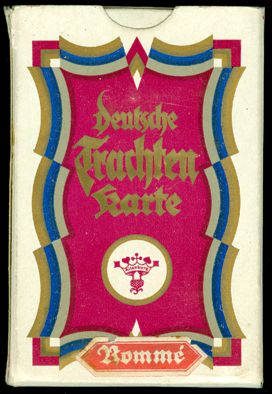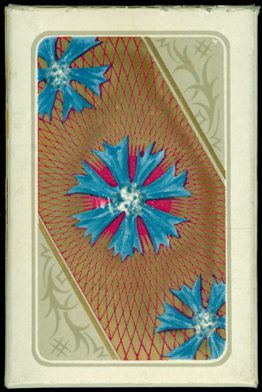March
2016
|
We had to wait until the 5th to hold this deck. |
|
|
Although
we have had our first spring days here, it hasn't been a very pleasant
month. Miriam spent about half of it in hospital, so Joop was on double
shifts again. Still there was time to follow the offer on the different
Ebay's and the Dutch auction site. |
But we
already knew then that we would present it here. Although we have
received other good non-standard decks, modern and vintage ones, they
couldn't top this deck. We should mention an unknown American fashion
advertising deck for our short list. |
|
Although there
was one more serious contestant, a modern designed vintage German deck, our
first choice remained the same. It's a deck that we first saw on the American
Ebay about 5 years ago. Unfortunately that seller didn't ship
internationally and our American friend who had offered to put a bid in for us
missed the auction and the (double) deck went for a ridiculously low price. So
last month we were pleasantly surprised to see a single deck on offer, again on
the American Ebay, and this time we managed to bring it home.
The deck was printed in offset and published as "Deutsche Trachten Karte"
(German Costumes Cards) by the Vereinigte Stralsunder Spielkartenfabriken
A.G. Werk Altenburg Thür(ingen). There's no date on the box and only a tax
stamp on the Ace of Hearts as indication. So we had to search the internet for
this info. It's probably a not very often seen deck, as there was only one
reference to be found and it led us to Peter Endebrock's site. According to his
information the tax stamp was in use between 1929 and 1931, but -even better- he
has this deck in his collection, shows it on his site and has dated the deck
there as 1927.
The courts and
aces are double imaged, but each side shows a different portrait of a famous
German on the Kings and women and men in costume from two different regions on
the Queens and Jacks. The courts, aces and joker were designed by Oskar Jacobi
(1862-1949) and all the designs are fine in detail and well worth showing,
without you having to strain your neck. So click HERE
to see the other sides up.
|
Richard
Wagner (1813-1883) was a German composer, who was born in Leipzig and,
after living in different European cities, died in Venice. |
|
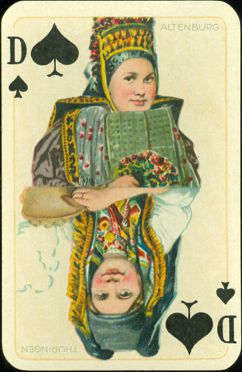
|
|
Until 1920
Altenburg was the capital of the Saksen-Altenburg Duchy, and since then
part of the present state of Thüringen. |
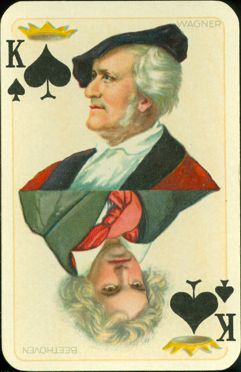 |
|
|
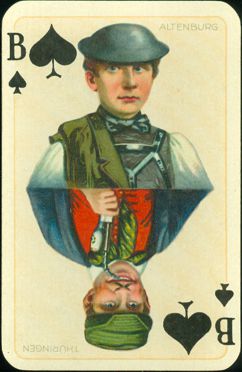
|
|
|
|
|
|
|
|
|
|
|
|
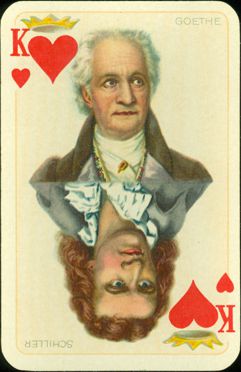
Johann Wolfgang von Goethe lived from 1749 until 1832. He was a poet,
author, philosopher, scientist and statesman.
|
|
Schaumburg-Lippe,
a principality between 1807 and 1918 is nowadays a part of Niedersaksen, a
German state. |
|
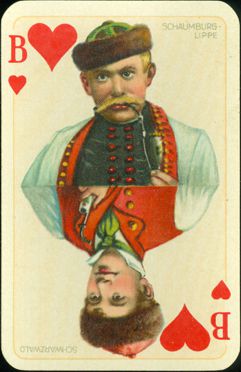
Schaumburg?
Isn't that the name of the American town where this years 52+ Convention
will be held. |
|
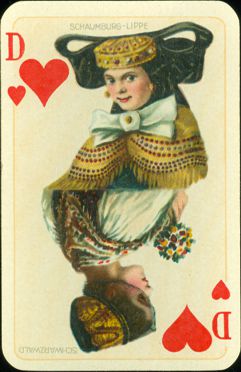
|
|
|
|
|
|
|
The aces
show views of German cities, castles and even a monument, a lake and an island.
The "90" on the tax stamp refers to the place where it was printed:
Altenburg.
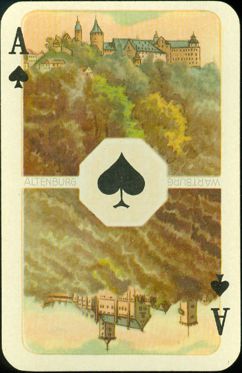
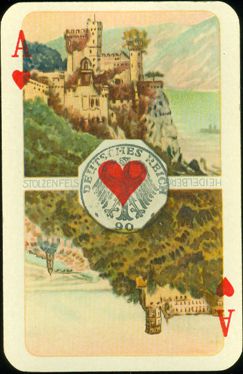
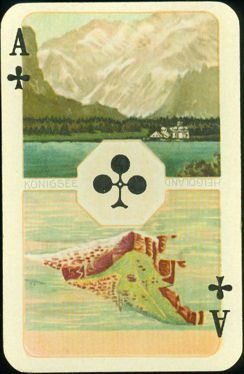
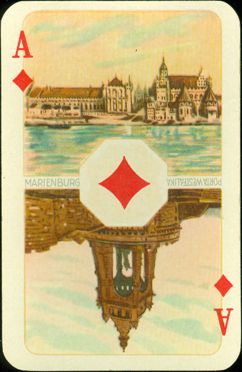
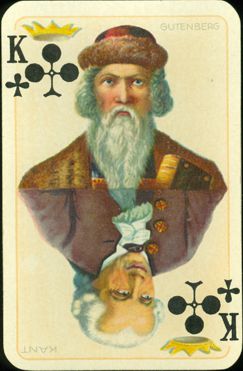
Johannes
Gutenberg (c1400 - 1468) was the inventor of book printing with
separate, movable letters. His main work is the Gutenberg Bible. |
|
Vierlande(n)
is a small area of 77 square kilometers near Hamburg, along a stretch of
the Elbe river. |
|
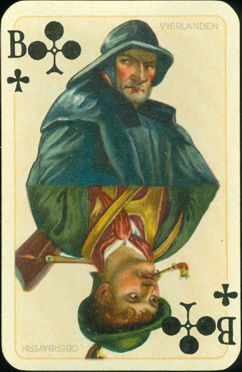
The Queen
shows the Vierlanden costume for ladies from the 18th century. The Jack is
shown as a fisherman, not in typical costume. |
|
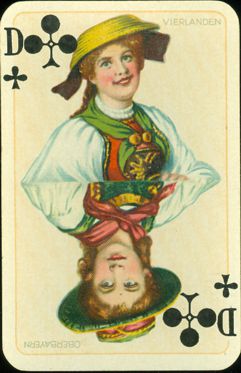 |
|
|
|
|
|
|
|
|
|
|
|
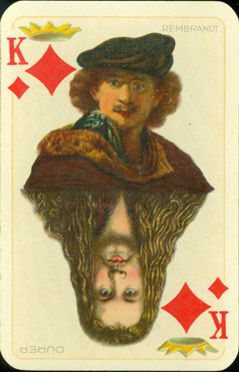 |
|
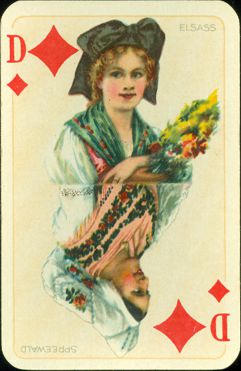 |
|
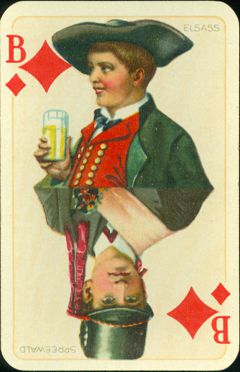 |
|
|
|
The depicted figures in the
Diamond suit are a bit controversial. |
|
|
A simple mistake or a sort of wishful thinking?
The depicted famous 17th century painter Rembrandt is not a German, but of
Dutch origin, born in Leiden in 1606 and living and working most of his life in
Amsterdam until his death in 1669. His presence in this deck is at least questionable.
The shown costumes are from the Elsass (Alsace), but that region has been
a source of dispute between the French and the Germans since the days of
the Frankish Empire (5th century AD), when the Franks defeated the
Alemanni. The latter had introduced the Germanic language in this region after the
decline of the Roman Empire and this (German based) Alsatian dialect has been
spoken there until the last quarter of the 17th century, when French
became the official language, although Alsatian and German were tolerated.
With the exception of the years during WWI and WWII, French is
still the official language. Nowadays the Alsatian dialect is
promoted again, as other regional languages in France (and the EU), and taught at schools on a voluntary basis.
At the time that this deck was printed the Alsace was officially French
territory, so one may wonder why this region was added to this German
Costumes deck. Wishful thinking or already promoting the idea of a Greater
Germany, of which the Alsace and Holland would be part?
|
The deck has 52
cards and a joker.
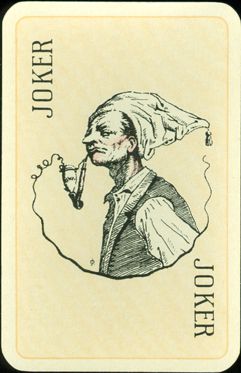
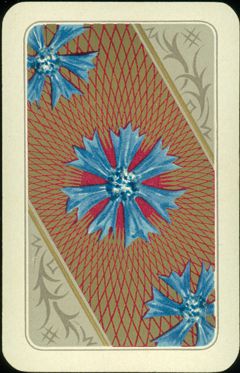
The box.....
BACK
TO PRESENT MONTH


















